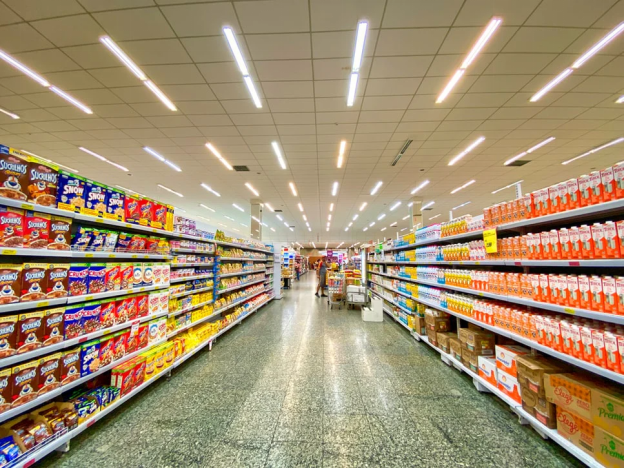Introduction
Linear lighting, characterized by its sleek and elongated format, offers a modern approach to illuminating spaces with both precision and efficiency. Unlike traditional point light sources, linear lighting systems distribute light uniformly across a continuous line, making them ideal for highlighting architectural details and enhancing ambient lighting. This form of lighting integrates seamlessly into various environments, from sophisticated commercial settings to intimate residential spaces.
The core technology behind linear lighting is the Light Emitting Diode (LED). LEDs have transformed the lighting industry with their compact size and robust efficiency, making them perfect for linear configurations. These devices convert electricity into light using semiconductor materials, which emit photons when electrically stimulated. Unlike incandescent bulbs, which produce light through heat, LEDs generate light through electroluminescence, resulting in superior energy efficiency and reduced heat production.
One of the significant advantages of using LEDs in linear lighting is their scalability and adaptability. They can be mounted on flexible strips or rigid bars, accommodating various lengths and installation needs. This flexibility allows designers to craft unique lighting solutions that conform to specific design aesthetics and functional requirements. Additionally, the low profile of LED-based linear lighting systems ensures a discreet presence, making them an excellent choice for under-cabinet lighting in kitchens, cove lighting in theatres, or accent lighting in art galleries.
Moreover, the advancement in LED technology has led to improvements in light quality and output. Modern LEDs can produce a spectrum of colors and brightness levels, all while maintaining high color accuracy and consistency. This capability ensures that linear LED lighting not only serves practical lighting needs but also enhances the visual appeal of spaces without the harshness or glare associated with older lighting technologies.
In summary, linear lighting represents a versatile and efficient solution for both decorative and functional lighting applications. Its adoption of LED technology complements its design flexibility, making it a preferred choice for forward-thinking lighting designs that prioritize energy efficiency, longevity, and aesthetic flexibility. As we explore further, the benefits and applications of linear lighting will underline its pivotal role in modern lighting practices, confirming its status as a key player in the future of architectural and ambient lighting solutions.
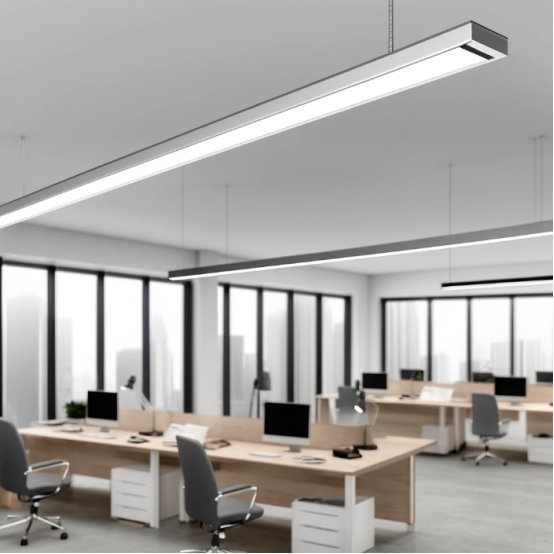
Components
Linear lighting systems are distinguished by their streamlined design, which is largely attributable to the sophisticated yet straightforward components that make up the system. Understanding these components is essential for anyone looking to implement linear lighting effectively, whether for commercial, industrial, or residential purposes.
LED Technology
At the heart of linear lighting systems are LEDs (Light Emitting Diodes), the small but powerful sources of light that have revolutionized the lighting industry. LEDs in linear lighting are often mounted on strips, which can be rigid or flexible, depending on the installation requirements. These LEDs are highly energy-efficient, converting a greater proportion of electricity into light rather than heat, which is a significant improvement over traditional incandescent and fluorescent light sources.
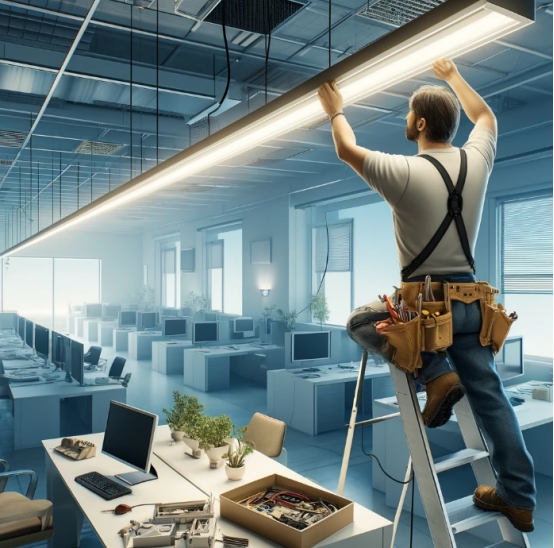
Light Strips
LED light strips are the primary component of linear lighting systems. These strips contain several LEDs spaced evenly to ensure consistent light distribution along the strip’s length. Available in various lengths and can be cut to size, these strips offer unparalleled adaptability and can be installed in virtually any space, from the edges of staircases to the undersides of kitchen cabinets
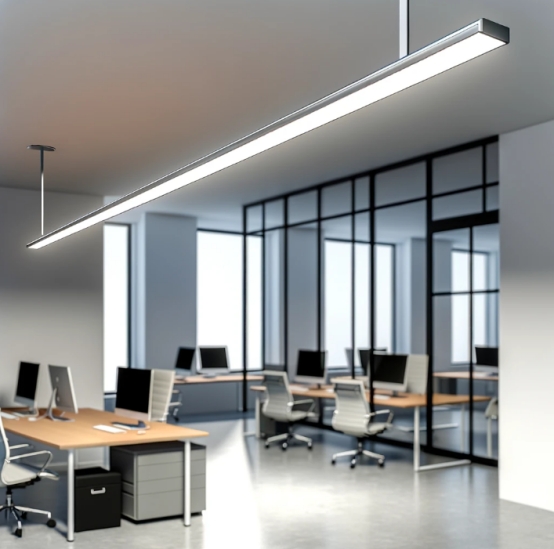
Diffusers
To enhance the aesthetic quality of the light emitted by LEDs, linear lighting often incorporates diffusers. These components help soften the light, reducing glare and spreading the light more evenly. Diffusers are crucial in applications where the light from the LEDs needs to blend seamlessly into the environment without creating harsh shadows or bright spots.
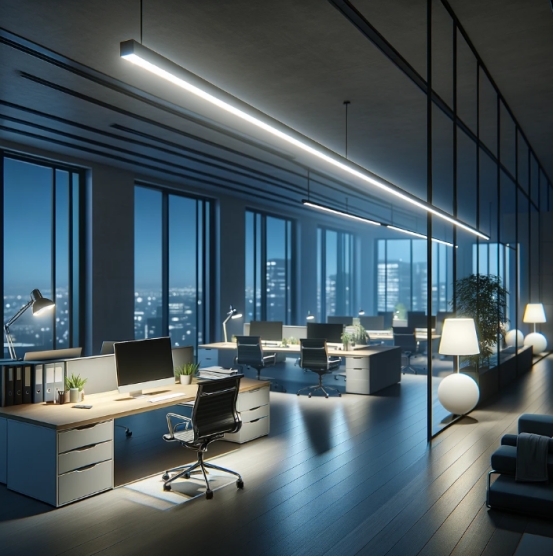
Connectors and Mounting Hardware
Connectors are vital for creating extended runs of lighting or for fitting strips into irregular shapes without losing conductivity. These small but critical components ensure that electricity flows smoothly across the lengths of LED strips, even around corners or across separate surfaces. Additionally, mounting hardware, which may include clips, brackets, or adhesive backing, is used to secure LED strips in place. This hardware is designed to be minimally invasive and often low-profile, maintaining the aesthetic integrity of the lighting design.
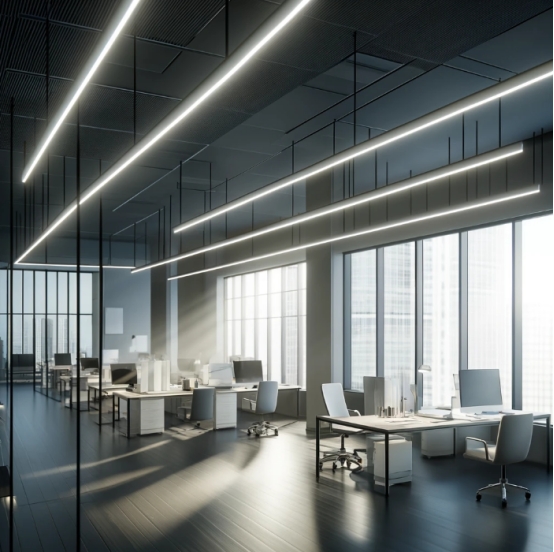
Drivers and Controllers
Drivers are necessary to convert the high-voltage power supply into a low-voltage format suitable for LEDs, ensuring the longevity and efficiency of the lighting system. Controllers, on the other hand, provide the ability to modify the brightness and color temperature of the LEDs. Advanced systems may include programmable options that allow for dynamic changes in lighting, supporting various ambiances and functionalities throughout a single space.
By integrating these components, linear lighting systems can offer a highly customizable and efficient lighting solution. The modularity of these systems lends itself well to innovative designs that require flexibility and precision, making linear lighting a preferred choice for modern, energy-conscious projects aiming to blend aesthetic appeal with practical functionality. As we delve deeper into the benefits of linear lighting, the importance of each component in achieving optimal lighting performance becomes increasingly apparent, highlighting the synergy that drives the success of these systems.
Benefits of Using Linear Lighting
Linear lighting systems, with their integration of advanced LED technology, offer a multitude of benefits that make them a superior choice for a variety of lighting applications. The advantages of adopting linear lighting extend beyond mere aesthetics, providing functional, economic, and environmental benefits.
Energy Efficiency
One of the most significant advantages of linear LED lighting is its energy efficiency. LEDs are renowned for their ability to produce a higher lumen output per watt compared to traditional lighting solutions. This means that linear LED lighting systems require less energy to produce the same or even better lighting levels, leading to substantial energy savings. This efficiency not only lowers utility costs but also reduces the carbon footprint of lighting systems, making linear lighting an eco-friendly option.
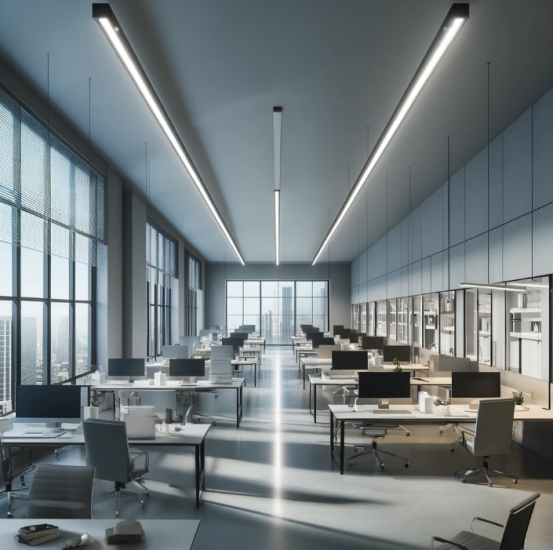
Extended Lifespan
LEDs inherently have a longer lifespan than traditional light sources such as incandescent and fluorescent bulbs. A typical LED used in linear lighting can last up to 50,000 hours or more under normal operational conditions. This extended lifespan reduces the need for frequent replacements, cutting down maintenance costs and the inconvenience associated with replacing traditional lighting. It also contributes to waste reduction, further enhancing the environmental benefits of LED-based linear lighting.
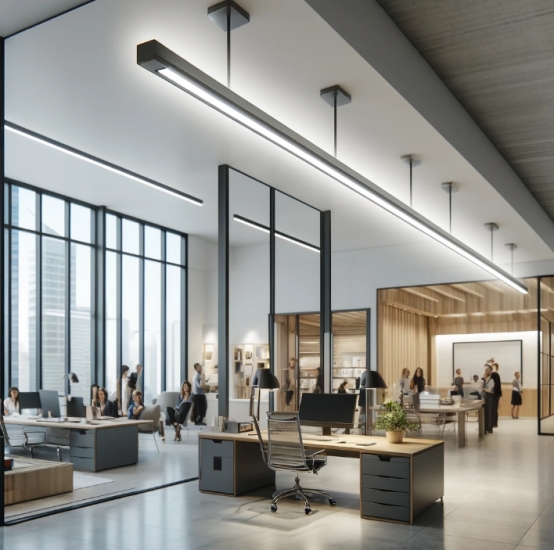
Flexible Design Options
Linear lighting offers unparalleled flexibility in design. LED strips can be cut to specific lengths and installed in virtually any space, regardless of its complexity. This adaptability allows designers to use linear lighting in innovative ways, such as in curved profiles, tight spaces, or areas that require uniform light distribution without visible bulbs or fixtures. The ability to customize the length and configuration of LED strips makes linear lighting an ideal solution for custom lighting designs.
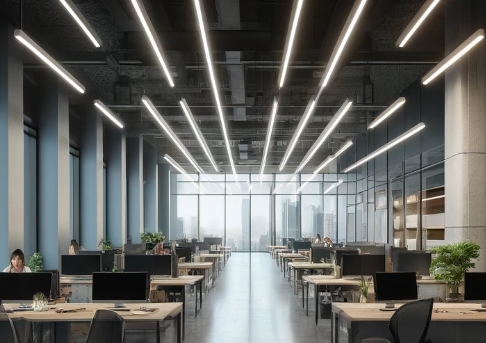
Improved Lighting Quality
LEDs used in linear lighting systems are capable of producing light in a range of color temperatures, which can be selected to enhance the mood or the functional requirements of a space. Moreover, LEDs provide excellent color rendering, which means they can reproduce the colors of the illuminated objects more naturally compared to other light sources. This feature is particularly important in settings such as retail stores, galleries, and other areas where accurate color representation is crucial.

Reduced Heat Emission
Unlike traditional lighting that converts a significant amount of energy into heat, LEDs are much more efficient in their energy use, emitting very little heat. This characteristic makes linear lighting safer and more suitable for use in sensitive environments where excess heat could damage displayed items or contribute to uncomfortable thermal conditions. The reduced heat emission also helps in maintaining a cooler and more controlled environment, leading to potential savings in air conditioning and cooling costs.
In conclusion, the benefits of using linear lighting are extensive, encompassing energy savings, enhanced aesthetic flexibility, prolonged operational life, and superior light quality. These advantages make linear lighting systems an appealing choice for anyone looking to enhance the efficiency and appeal of their lighting installations while adhering to sustainability and performance standards. Whether it is for commercial, residential, or specialized settings, linear lighting offers a tailored, efficient, and high-quality lighting solution that meets the demands of modern lighting challenges.
Applications of Linear Lighting
Linear lighting, powered by advanced LED technology, is remarkably versatile, making it suitable for a wide array of applications. Its ability to blend seamlessly into various architectural elements, coupled with its energy efficiency and superior lighting quality, enables its use in diverse environments—from residential settings to expansive commercial spaces and specialized applications.
Residential Applications
In residential spaces, linear lighting can transform interiors into visually striking environments while providing practical illumination. Common applications include under-cabinet lighting in kitchens, where it offers excellent task lighting for countertops without the shadows cast by overhead lights. Linear lighting is also perfect for cove lighting, where it can be used to add ambient light that bounces off ceilings and walls to create a soft and uniform light spread that enhances the room’s aesthetics without overpowering it.

Commercial and Retail Spaces
Commercial and retail settings benefit immensely from linear lighting. For retail spaces, linear LED lights can be used to highlight merchandise, enhancing colors and drawing attention to specific products. This strategic placement not only improves the visual appeal of the products but also influences purchase behavior. In commercial offices, linear lighting provides ample illumination that helps reduce eye strain and increase comfort for employees, which can lead to increased productivity.
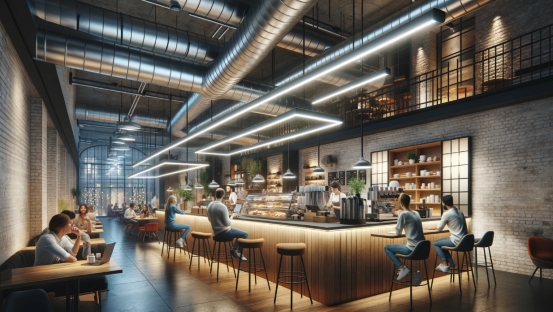
Industrial Applications
Linear lighting is also extensively used in industrial environments where reliable, robust, and energy-efficient lighting is crucial. Large warehouses, manufacturing facilities, and garages use linear LED systems to ensure consistent, bright lighting that covers extensive areas effectively. The durability and long lifespan of LEDs reduce the downtime and maintenance costs associated with lighting in such demanding environments.
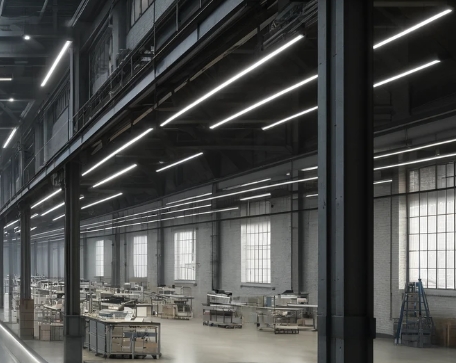
Outdoor and Architectural Lighting
The robustness of linear lighting systems makes them ideal for outdoor applications as well. Architectural features of buildings can be accentuated using linear lights, which highlight textures and shapes with precision and efficiency. Moreover, linear LED lighting can be integrated into pathways, bridges, and public spaces to enhance safety and aesthetics, contributing to urban beautification projects.
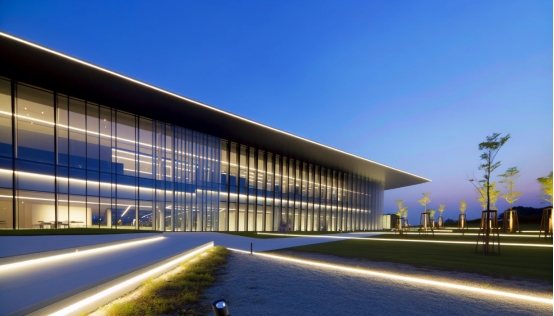
Creative and Decorative Uses
The flexibility and customizable nature of linear lighting open up creative possibilities for designers. It can be used in art installations, stage design, and other decorative applications where lighting plays a pivotal role in the overall visual presentation. The ability to control the color temperature and intensity makes linear lighting a dynamic tool for artists and designers, allowing them to create immersive environments that can be modified according to the desired ambiance.
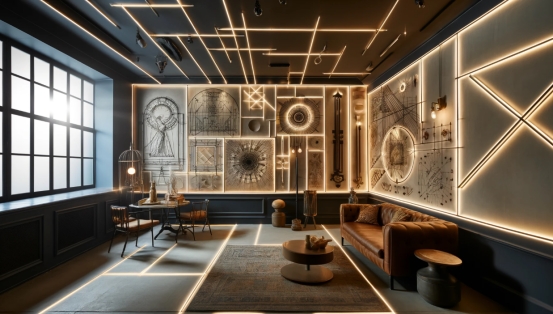
Specialty Applications
Specialty applications such as lighting for display cases in museums or jewelry stores benefit from the precise and quality lighting provided by linear LEDs. These settings require lighting that enhances the visibility of items without causing damage or fading, a task for which linear LED lighting is particularly well suited due to its low UV emission and excellent color rendering.
In summary, the applications of linear lighting are as diverse as they are numerous, stretching across various sectors and fulfilling both functional and aesthetic needs. Whether illuminating homes, offices, commercial spaces, or contributing to special artistic projects, linear lighting stands out as a flexible, efficient, and reliable lighting solution that meets a broad spectrum of lighting requirements.
Installation and Maintenance of Linear Lighting
Proper installation and regular maintenance are crucial for maximizing the performance and lifespan of linear lighting systems. Equipped with LEDs, these systems not only promise longevity and efficiency but also require specific considerations during installation and routine checks to maintain optimal function.
Installation of Linear Lighting
Planning and Layout: Before installation, careful planning of the layout is essential. This involves measuring the areas where the linear lighting will be installed, ensuring there is access to power sources, and determining the total length of LED strips needed. For custom applications, consider the flexibility of the lighting strips and the potential need for cutting them to fit specific spaces.
Electrical Connections: Safe and reliable electrical connections are paramount. It is advisable to involve a qualified electrician to handle the electrical aspects of the installation, particularly for integrating lighting controls and ensuring that the wiring complies with local electrical codes. This includes setting up power drivers that match the voltage and current requirements of the LED strips to prevent overloading and potential damage.
Securing the Strips: Depending on the type of linear lighting, various mounting options are available, such as clips, brackets, or adhesive backings. For surfaces that are exposed to moisture, heat, or frequent handling, more robust mounting solutions may be required to ensure the strips remain securely in place.
Testing: After installation, a thorough testing phase is crucial. This includes checking all connections and making sure that the entire length of the lighting functions correctly. Testing also helps verify that the lighting effect achieves the desired outcome, whether it’s task lighting, ambient lighting, or accent lighting.
Maintenance of Linear Lighting
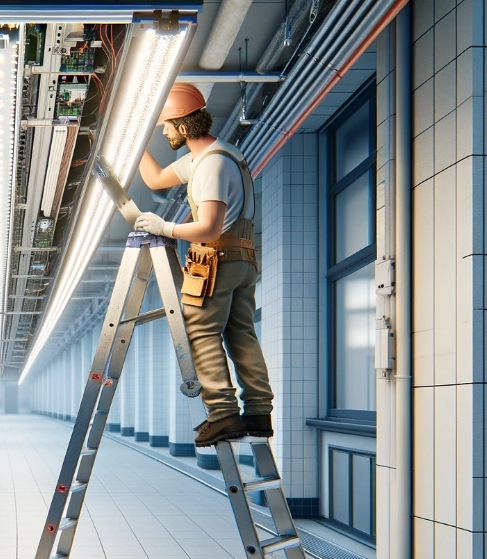
Routine Cleaning: Keeping the light strips free of dust and debris is important to maintain high light quality and efficiency. Regular cleaning with a soft, dry cloth can prevent build-up that might eventually obscure the light output. For environments prone to grease, such as kitchens, a damp cloth may be necessary.
Checking Connections: Periodically check all electrical connections and power supplies to ensure they are secure and not subject to wear. This is particularly important in areas with high vibration or where the lights are frequently adjusted or moved.
Replacing Components: While LED strips themselves have a long lifespan, other components such as drivers and controllers may need to be replaced periodically. Keeping an eye on the functionality of these components and replacing them before they fail can prevent interruptions in lighting.
Updating Settings: For systems with programmable controls, updating the settings to suit changing room uses or preferences can revitalize the space without the need for physical adjustments to the lighting setup.
By following these guidelines, the installation and maintenance of linear lighting systems can be managed effectively to ensure that they provide reliable, efficient, and aesthetically pleasing illumination for many years. These practices not only safeguard the investment in high-quality lighting but also enhance the overall functionality and ambiance of the space they illuminate.
Future Trends in Linear Lighting
As linear lighting continues to carve out a significant niche in both architectural and functional applications, its evolution is propelled by ongoing advancements in LED technology and design innovation. The future of linear lighting looks promising, with trends pointing towards more intelligent, sustainable, and versatile lighting solutions.
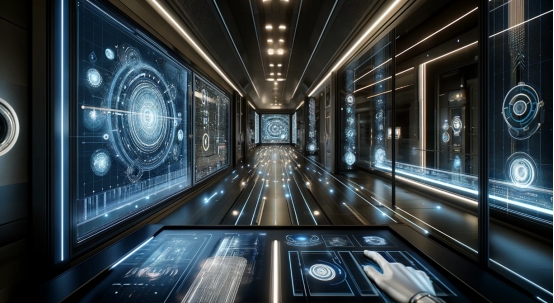
Increased Integration of Smart Technology
Smart technology integration is set to redefine how linear lighting systems operate. Future linear lighting systems will likely incorporate advanced sensors and IoT connectivity, allowing for real-time environment monitoring and automated adjustments. This could mean lights that adjust their brightness and color temperature based on the time of day or the occupancy of a room, enhancing both energy efficiency and user comfort.
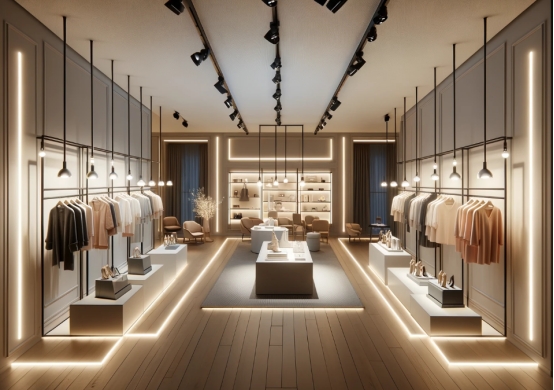
Enhanced Energy Efficiency
While LEDs are already known for their energy efficiency, there is a continuous push to develop LEDs that consume even less energy while delivering superior light output. Innovations in semiconductor materials and LED design are expected to improve the lumens per watt ratio, reducing the energy footprint of linear lighting systems even further. This trend is crucial as global energy policies become stricter and the demand for sustainable building practices increases.
More Flexible and Customizable Options
As the demand for personalized lighting solutions grows, the future will see linear lighting becoming even more customizable. This could involve enhancements in the flexibility of the strips themselves, allowing for installation around complex architectural features without compromising on performance. Additionally, the ability to customize the length and even the direction of light emission on-site will cater to a broader range of design preferences and functional requirements.
Advancements in Color Tuning
Color tuning technology in LEDs is set to advance, offering more precise control over the light spectrum emitted by linear lighting systems. This will benefit applications requiring high color accuracy, such as in museums and galleries, and will enhance the ambiance in hospitality settings. With advancements in color tuning, users will not only be able to adjust the intensity of the light but also its color balance and saturation, all through simple control interfaces.
Improved Durability and Longer Lifespans
Research in LED longevity and durability will likely result in linear lighting systems that are even more robust and long-lasting. This includes the development of LEDs that can withstand a wider range of environmental conditions, from extreme temperatures to higher humidity levels. Improvements in the encapsulation techniques and materials used for LED strips will enhance their resistance to physical and environmental stressors, extending their operational life and reducing maintenance needs.
Growth in Biophilic Design Applications
Linear lighting will play a significant role in biophilic design, where the connection between nature and man-made environments is emphasized. LED technology allows for the simulation of natural light patterns within indoor spaces, supporting human circadian rhythms and enhancing well-being. Future developments in linear lighting could include dynamic adjustments that mimic natural light more closely, promoting healthier indoor environments.
The trajectory for linear lighting points towards a convergence of technology, design, and sustainability. As we look to the future, it is clear that linear lighting will not only illuminate spaces but will also enhance the way we live and work, adapting to our needs with greater intelligence and efficiency. As these technologies evolve, they promise to bring about a new era in lighting design, marked by an even greater alignment with human and environmental needs.
Conclusion
The exploration of linear lighting, particularly through the lens of advanced LED technology, reveals a dynamic and rapidly evolving landscape that promises to reshape our approach to both functional and aesthetic lighting. As we have traversed the various facets of linear lighting—from its fundamental components and installation to the exciting potential future trends—it is evident that this technology is not just about illumination but about enhancing the quality of spaces where people live, work, and interact.
Linear lighting systems, underpinned by LED technology, offer a compelling array of benefits that address today’s critical needs for energy efficiency, sustainability, and customized lighting solutions. These systems provide significant energy savings, reduced environmental impact, and the flexibility to adapt to a multitude of design specifications and personal preferences. Moreover, the potential for integration with smart technology and IoT devices stands to further elevate the functionality of linear lighting, making it an intelligent choice for future-ready lighting installations.
As we look forward, the continuous advancements in LED technology and digital control systems are poised to expand the capabilities of linear lighting even further. The future points towards lighting solutions that not only respond in real-time to environmental and user inputs but also contribute to well-being and productivity through enhanced color accuracy and circadian rhythm support.
In conclusion, linear lighting represents a fusion of innovation, design, and technology that transcends traditional lighting applications. It offers architects, designers, and end-users a powerful tool to create environments that are both beautifully illuminated and optimally functional. The ongoing evolution of linear lighting promises to keep it at the forefront of lighting technology, making it a perennial choice for those seeking a blend of performance, aesthetics, and environmental consciousness in their lighting solutions. As such, linear lighting is not merely a trend but a sustainable lighting solution poised for continued growth and integration into the fabric of future architectural and design projects.
